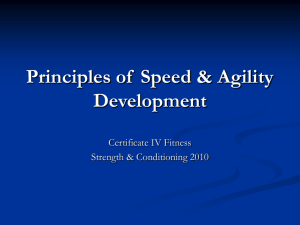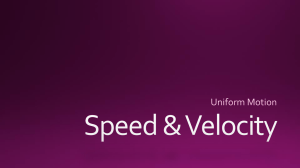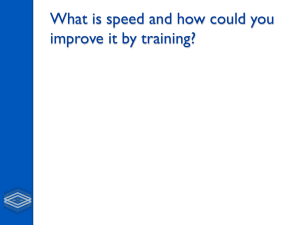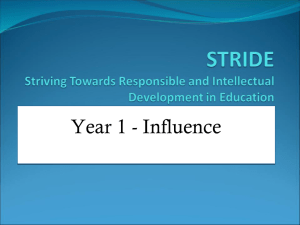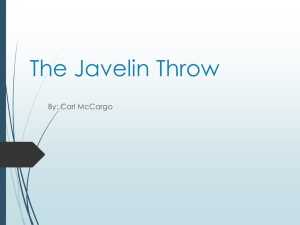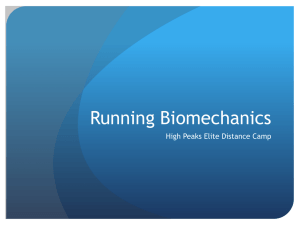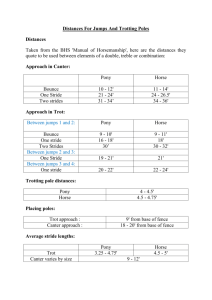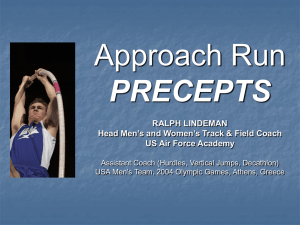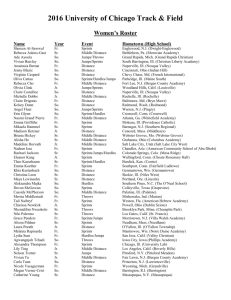Speed Development
advertisement
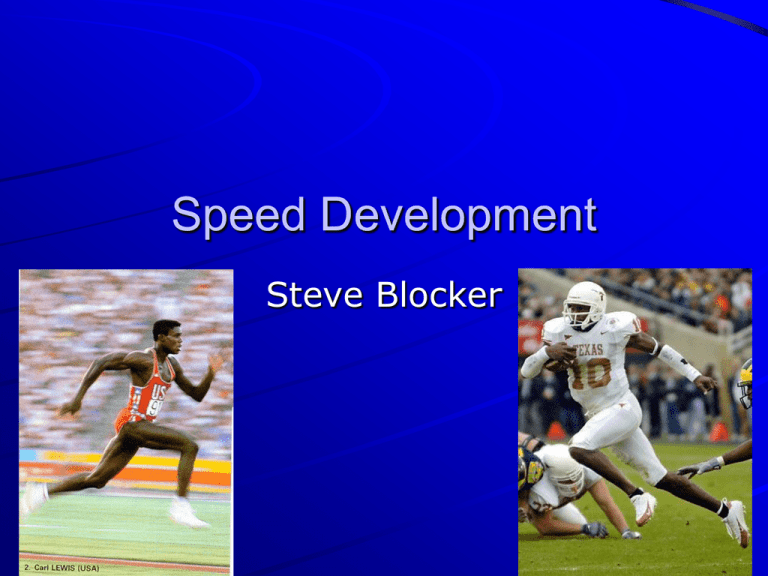
Speed Development Steve Blocker Introduction Why Important? What is speed? Limiting Factors How to improve – Technique – Training methods – Periodization Importance of Speed Improving all around performance Possible difference maker Taking performance to higher level What is Speed? Terminology Speed: ability to achieve high velocity or stride length x stride frequency Speed Endurance: Metabolic capacity to maintain performance (Conditioning) – Ability to repeatedly accelerate (6+s bouts) Terminology Speed Strength: ability to apply force rapidly- Rate of Force Development (RFD) Special Endurance: sport-specific exercise-relief patterns Drive Phase: initial acceleration phase approximately 30-50m – May be shorter for non-track sprinters Terminology cont’d Max Velocity Phase: occurs as the athlete achieves maximal velocity or “top end” speed Occurs at approximately 40-50m for elite sprinters – Occurs earlier in non-track athletes (2530m) Mero, Komi & Gregor, 1992 Factors That Affect Speed Technical vs. Physiological Technique & Physiology Different phases of sprinting – acceleration & max velocity Strength – Maximalrelative/absolute – Reactive-stretchshortening cycle (SSC) – Rate of Force Development (RFD) Importance of Technique Maximize efficiency of movement Minimize flight time Minimize ground contact time Results in optimal stride length and stride frequency Faccioni Acceleration-General Concepts Explode from start position Accelerating as rapidly as possible Stride length emphasized An emphasized horizontal displacement Common Problems-Acceleration Phase Athlete stands up too early First stride is too long/short “Skating” action in initial steps Acceleration Technique Acceleration Phase – Maximize arm/knee drive – Emphasize horizontal displacement – Tucked chin with eyes focused up – Forward lean – References Acceleration Drills Push-Up Starts Resisted Sprints Hill Running Sprints to 10/20/30/40m from a 3-pt start Maximal Velocity-General Concepts Occurs at approximately 4050m in elite sprinters Attempt to maintain maximal velocity as long as possible Stride Frequency emphasized Common Problems-Max Velocity Phase Over striding – Breaking forces Rotational movement – Arms cross mid-line of body Heel Strike Lordosis – Arched back Max-Velocity Technique Emphasize “rotary” running action Keep relaxed Maximize stride frequency “Chin to Pocket” (Shoulder ROM) Physiological Aspects STRENGTH – Maximal absolute/relative – Reactive strengthSSC – RFD Physiological Aspects Accelerate quickly Reach a high velocity Greater level of force production (strength) Apply force as fast as possible (RFD) Max Strength Get Strong!!! – Maximize force output – Elite sprinters can minimize ground time w/out reducing stride lengthrequires leg strength – Mero, Komi & Gregor 1992 Reactive Strength Plyometric Training – Improves reactive strength – Improves rate of force development Bounding/Box Jumping Reactive Strength/Max Velocity Workout Design Train for speed/agility early in session/week Least amount of fatigue – Greater risk of injury – Poor kinematics/technique Plisk, 2000. Periodization 4-8 week mesocycles – USAW Level I – Base, Volume, Unload, Peak 1-3 days/week Volume depends on: – Sport – Position – Time of training year Training Session Begin with a dynamic warm-up Slow & general exercises Dynamic & specific – Opportunity to teach technique Speed Training Methods Varied pace sprints ins & outs Bounding & plyometrics Fliers-sprints from on the fly Push up sprints-acceleration phase Sprints from 3-pt start position Workout Plan Day1 Day2 Day3 Day4 Speed maxspeed Anaerobic capacity Speed Anaerobic Speed capacity acceleration (moderate) Or recovery Day5 Day6 Day7 Active Recovery Off Sample Workout Day 1 Day 2 Day 3 Day 4 Day 5 Day 6 Day 7 Dynamic Warm up 3x40m alternate leg bounding 3x3x30m “fliers” 2min/4min rest Dynamic Warm up 6 hurdle jumps 4-5 sets of 10 tuck jumps+30m sprint+10 squat jumps+60 m fly. 4min rest Dynamic Warm up 1x3x10m push-up sprints 3x3x20m push up sprints Dynamic Warm up Hill Runs 3x5x6080m or tempo track workout Emphasize running technique Dynamic Warm up 3x40m alternate leg bounds 1x3x10m push up sprints 1x3x20m push up sprints Hard Track Workout Short Hills 3x3x3050m hills @ 75% effort Emphasize technique OFF Conclusions Keep it simple Specific Progressive Scientific Do Research References Plisk, Steven S. Speed, Agility, and Speed-Endurance Development. In Essentials of Strength Training and Conditioning. T.R. Baechle & R.W. Earle. National Strength and Conditioning Association. 2000. Champagne, Ill 2000. Cissik, John M. Means and methods of speed training: part II. National Strength and Conditioning Association Journal. 27(1). 18-25. 2005. Chu, D. and Korchemny, R. 1989. Sprinting stride actions: Analysis and evaluation. National Strength and Conditioning Journal. 11. 81-85. References cont’d Dinitiman, G.B. Effects of various training programs on running Speed. Res. Quart. 35. pp 456-463. Komi, P.V. 1992. Strength and Power Development in Sport. Blackwell Scientific Publications. Korneljuk, A.O. 1982. Scientific basis of sprint speed Development. Track and Field Quart. Rev. Summer. Pp6-9. Mann, R. 1985. The elite athlete project- sprints and hurdles. Track Tech. 84. Pp 2672-2675.

